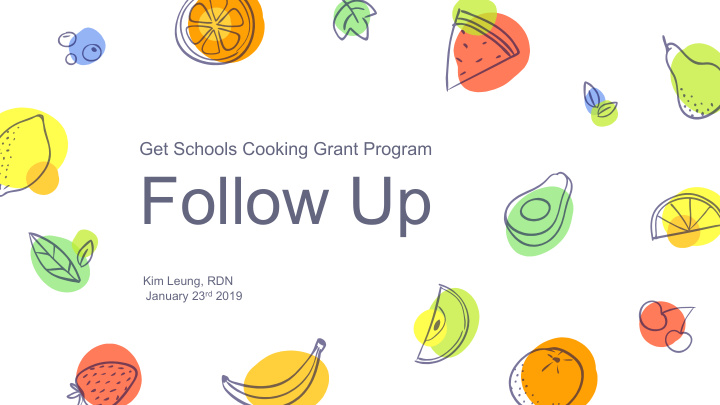



Get Schools Cooking Grant Program Follow Up January 23 rd 2019 Kim Leung, RDN
Goals of the Assessment With consideration of the district’s primary goal to improve food quality, use fresh ingredients and fully transition to scratch-cooking: q Assesses current conditions in the Food Services Department q Identifies Strengths q Identifies Key Challenges and Barriers to Change q Isolates Next Steps q Provides Strategies to Address Challenges q Provides Tools and Technical Assistance
What is the Vision?
Recommendation Labor Efficiency & Increasing Participation Specifically Breakfast!
Basic Aid Funding Impact on Food Services Basic Aid Funded Districts Revenue & Costs Fixed Federal Reimbursement Total LCFF Funded Districts Revenue & Costs Dollars $ Students
Proposed Reorganization Savings Labor Efficiency $76,000
School Site Reorganization Current Class Revised Class Food Service Worker 2 Satellite Lead* Food Service Cashier Satellite Assistant* *some site hours change based on MPLH
Central Kitchen Reorganization Current Revised Current Class Days Revised Class Days Hours Hours Assistant to the Director* 8.00 195 Supervisor 8.00 226 FSW III 8.00 182 Production Cook 8.00 197 FSW III 8.00 182 Production Cook 8.00 197 FSW III 8.00 182 Production Cook** 8.00 197 Central Kitchen FSW III 8.00 182 Production Assistant 7.00 197 FSW III 7.00 182 Production Assistant 7.00 197 FSW III 4.75 182 Central Kitchen Utility 5.00 197 FS Driver 2.50 226 FS Driver 4.00 226 Total 58.25 51.00 *Classified position, states in job description “serves as the FS Director in their absence” **Get Schools Cooking recommends to assess need for 3 vs 2 production cooks
Labor Efficiency & Increasing Participation Specifically Breakfast!
1 out of every 5 kids does not eat breakfast. Gleason, P., & Suitor, C. (2001). Children’s diets in the mid-1990s: Dietary intake and its relationship with school meal participation. Nutrition Assistance Program Report Series, No. CN01-CD1. Alexandria, VA: USDA, FNS, Office of Analysis, Nutrition and Evaluation. p 61.
71% of low-income K-12 students in SB County are reached by the National School Lunch Program, but only half take advantage of the breakfast program. Santa Barbara County Food Action Plan 2016
Breakfast Participation
“ … SBPs have a positive effect on children's Educational academic performance with clearest effects on Impact of mathematic and arithmetic grades in undernourished children. Increased frequency of Breakfast habitual breakfast was consistently positively associated with academic performance.”
༝ Experiencing hunger impairs children’s ability to learn. ༝ Eating school breakfast improves children’s attendance. ༝ Educational Eating school breakfast improves behavior and learning environments. Impact of ༝ Eating breakfast at school reduces tardiness and Breakfast absenteeism. ༝ Children who eat breakfast are more likely to maintain a healthy body weight. Chef Ann Foundation, The Lunch Box Financial Increased revenue from 24-30% $125,000 to 70% Free/Reduced student Impact of breakfast participation Breakfast
༝ Barriers to Lack of time Breakfast ༝ Lack of knowledge ༝ Lack of marketing ༝ Lack of equipment ༝ Transportation schedules ༝ Stigma ༝ Conflicting programs (before school clubs/ practices)
༝ Increasing Participation ○ Transportation/Bus Schedules Breakfast ○ Alternative Breakfast Models Recommendations ○ Morning Activities
Summary Assessment of Food Services Labor Breakfast Participation - Reorganize Sites - Alternative breakfast models - Reorganize Central Kitchen - Busing schedules - Morning programming
Questions? Lunch Lessons 2018
Recommend
More recommend